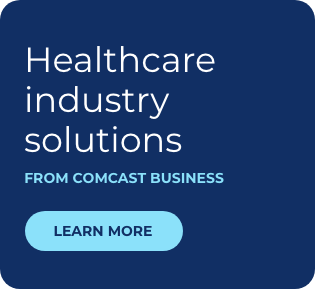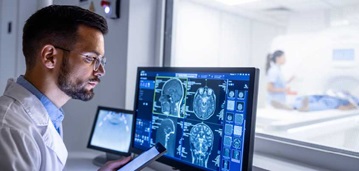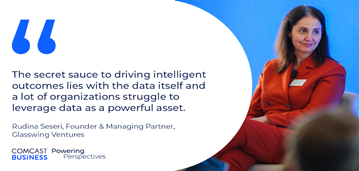The Role of Data in Driving Exceptional Customer Experiences in Healthcare

Healthcare has been radically transformed by technology, enabling providers and caregivers to provide increasingly higher-quality care at a more rapid pace. Along the way, technology has done much to improve the experience of healthcare providers, as they deliver highly personal yet effective care, and of patients, as they benefit from such care.
Indeed, healthcare technology has transformed the patient experience, extending the doctor/patient relationship beyond the healthcare facility and enabling smarter, more accurate treatment through an expanded healthcare ecosystem. Thanks to technology, caregivers are no longer constrained in how and where they treat patients, and patients are no longer constrained in where they are treated.
Technology adoption continues to move at a rapid pace in the healthcare sector, with core technologies such as electronic health records (EHRs) and telemedicine improving and newer technologies such as artificial intelligence gaining ground. Data is driving health care today more than ever, and technologies that can make sense of—and derive value from—healthcare data will be much sought-after moving forward.
Such data-centric technologies rely on the right network to be effective in helping healthcare organizations improve their patient experience. However, traditional IT infrastructures were not designed for the workloads of today’s data-intensive technologies. To help close the gaps in network capability, organizations in all sectors are complementing their existing networks with newer technologies, such as software-defined networking, that are designed to provide much-needed capacity, speed and support.
Improving Health Care’s Profile
It’s no secret that technology plays a critical role in tackling myriad issues in health care that range from helping researchers track trends in chronic diseases among certain populations to ensuring the security and availability of patient health records. According to Deloitte’s “2019 Global Health Care Outlook,” the health technology sector is expected to reach USD $280 billion by 2021, driven in large part by the need to address aging and growing populations, clinical advances and rising labor costs.1
Data’s role cannot be underestimated in its importance as a catalyst for higher-quality health care with better outcomes. Its role in helping to improve the patient experience is also growing, as more doctors and caregivers use the information derived from data analytics to provide patient-centric services such as personalized health care and self-monitoring.
Data, Enabled
The proliferation of technologies such as Internet of Things (IoT) devices and connected sensors, smart watches, and personal wearable devices such as insulin pumps give doctors and caregivers more access to patient data in real-time, enabling them to make faster and more informed changes to treatments. Such capability not only can help the patient get well faster, for example, but also save the healthcare facility money by increasing the speed and effectiveness of the treatment.
And, once the patient has been treated successfully, the facility can track the patient’s health digitally to ensure they remain healthy. And, should the patient need to see a doctor, data from the connected devices can be transmitted before the patient arrives so the caregivers have the most up-to-date information available.
Electronic health records, meanwhile, are perhaps the largest example of a data-centric healthcare application, including patients’ personally identifiable information, medical history and test results, among other information. Their use is increasing, as more healthcare organizations adopt EHR technology and patient records are available to practitioners in multiple locations, ensuring patients are treated according to their medical history, not physicians’ best guesses.
Also making its mark in health care is artificial intelligence, which is helping researchers and caregivers alike provide the best care. In the research realm, AI has the potential to help streamline the drug discovery and repurposing process, potentially reducing the time to market and costs associated with developing new drugs—which, in turn, could mean lower prices for patients.2
AI is also working alongside physicians to better diagnose ailments and spot healthcare trends such as the onset of epidemics. Perhaps the most well-known of AI applications in health care is IBM’s Watson Health, which is being used in various facilities to apply cognitive computing, parsing through vast repositories of health data in record time, to determine a condition and appropriate treatment. Patients are treated faster and more accurately. Watson Health is also being used in helping healthcare organizations address issues, including inefficient care programs, biased decision-making, fraud and more—all areas where patient experience can be severely impacted.3
AI is also being used by researchers to help physicians better determine a treatment plan for Parkinson’s Disease simply by listening to vocal patterns of patients and determining how far the disease has progressed.4 Such technology can help healthcare providers diagnose Parkinson’s earlier, which could lead to improved outcomes and better quality of life for the patient.
Securing All the Data
The data deluge driving such innovation in health care is a gold mine of information. As such, it is a prime target for cybercriminals. The intercommunication between provider, patient and insurance company—along with organizations connected to the provider’s digital supply chain—provide fertile ground for bad actors to infiltrate networks and extract data.
In 2018, more than 15 million patient records were breached, an increase of 3x from 2017, with 102 of reported cases involving third-party companies or business associates.5
At the same time, the U.S. is experiencing a dearth of cybersecurity professionals—so much so that entire sessions are devoted to the topic at major cybersecurity events including RSA Conference. A 2018 study by non-profit cybersecurity association (ISC)2 determined that currently, there is a shortage of 3 million cybersecurity professionals worldwide,6 a number that the organization expects to rise.
Artificial intelligence is stepping in to fill the security gaps in many organizations, helping keep sensitive data, including patient records, secure. In fact, according to Capgemini’s “Reinventing Cybersecurity with Artificial Intelligence” report, more than half of executives surveyed are using AI for cyber threat detection, with even more saying AI both lowers the cost to detect and respond to breaches and reduces the time it takes to detect threats and breaches.7
In an industry rife with data breaches, ensuring sensitive data stays secure from cybercriminals can go a long way to improving patient experience and overall satisfaction.
Other Ways Data is Working for Health Care
While some ways in which data is being used in health care are more obvious, other methods are less so. For example, both inside and outside healthcare facilities, a growing selection of tracking devices is helping caregivers keep track of the location of Alzheimer’s patients. The trackers use a GPS signal to show where they are at all times, should they get lost and confused while traveling alone.
And in some rural school districts, telemedicine devices are being used to provide speech therapy for students who need it. The school nurse and the student are connected to the speech pathologist, who works with the student via video. The nurse oversees the therapy and offers assistance when necessary. Such practice not only provides much-needed services to rural districts, but it also is helping meet the demand for speech therapy services in general.
Networking: The Great Data Enabler
Healthcare organizations understand the need to provide exceptional patient experiences, yet many recognize their networks are not capable of supporting the various data-centric applications and services available today.
As a result, many organizations are adding to or upgrading their networking infrastructure in ways that don’t require “ripping and replacing” their current technologies and enable them to derive continued value. Adding software-defined networking technologies to complement their existing MPLS network, for example, can add needed capacity to run data-heavy workloads without stressing the network and increase the speed of data consumption from all points on the network.
Likewise, edge networking is coming into its own among organizations dealing with data-intensive workloads. Pushing network intelligence to the edge will enable data to be processed at the edge of the network—on edge devices such as routers or switches—rather than at the data center, reducing bandwidth needs and accelerating response. Both cloud and on-premises data centers can benefit from the reduced latency and increased processing power afforded by edge networking.
Organizations that don’t have the ability to upgrade their networks, due to cost, capacity or other reasons, can turn to managed services providers to “fill in the gaps” of their current infrastructure. Managed services can handle network, security and almost everything in-between, enabling organizations of all sizes and business models to take advantage of the latest in digital transformation technologies without spending all their time and efforts on managing their networks.
Conclusion
The healthcare sector increasingly is relying on data to help provide exceptional care through better diagnosis, reduced costs and better data security—all of which are critical to ensuring a high-quality patient experience. Analytics, artificial intelligence and other technologies are making their mark in healthcare facilities as the means by which organizations and providers get the information necessary to make more informed and more intelligent decisions.
As data become ever-more integral to caregiver decisions, networks must be able to manage the massive amounts necessary to enable data-driven decision-making. The networks on which data-intensive technologies run are critical, yet such technologies can easily overload networks built with and using yesterday’s technology. Providing the right infrastructure to support data-heavy workloads is paramount in ensuring delightful customer experiences.
Comcast Business partners with enterprises to improve network performance, and with dynamic solutions, expansive resources and leading expertise, help forward-thinking companies create value in their core business by leveraging network-dependent technologies.
Learn more about how Comcast Business can support the goals of healthcare organizations. https://business.comcast.com/enterprise/industry-solutions/healthcare
[1] “2019 Global Health Care Outlook,” Deloitte, research report, March 2019
https://www2.deloitte.com/global/en/pages/life-sciences-and-healthcare/articles/global-health-care-sector-outlook.html
[2] “No longer science fiction, AI and robotics are transforming healthcare,” PWC microsite,
https://www.pwc.com/gx/en/industries/healthcare/publications/ai-robotics-new-health/transforming-healthcare.html
[3] IBM Watson Health homepage, IBM,
https://www.ibm.com/watson/health/business-need/
[4] “Speech Analysis May Help Diagnose Parkinson’s and at Earlier Stage, Study Says,” Parkinson’s News Today, February 2018,
https://parkinsonsnewstoday.com/2018/02/05/speech-analysis-can-help-detect-parkinsons-in-early-stages-study-says/
[5] “2019 Annual Breach Barometer Report,” Protenus, Feburary 2019, https://www.protenus.com/2019-breach-barometer
[6] “(ISC)² Cybersecurity Workforce Study, 2018,” (ISC)2,
https://www.isc2.org/-/media/7CC1598DE430469195F81017658B15D0.ashx
[7] “Reinventing Cyber Security with Artificial Intelligence,” Capgemini, July 2019,
Reinventing Cybersecurity with Artificial Intelligence
Data-centric healthcare tech requires the right network to improve patient experience.
Locked Content
Click on the button below to get access
Unlock NowOr sign in to access all content on Comcast Business Community
Learn how Comcast Business can help
keep you ready for what's next.



.tmb-.png?Culture=en&sfvrsn=2442f4ef_1)





.png?sfvrsn=2442f4ef_1&MaxWidth=366&MaxHeight=171&ScaleUp=false&Quality=High&Method=ResizeFitToAreaArguments&Signature=C35D8D9A9E81C78439D0619D15B4D29512E0274F)

